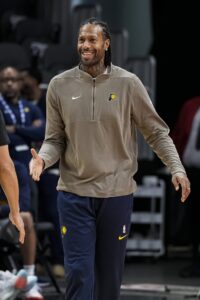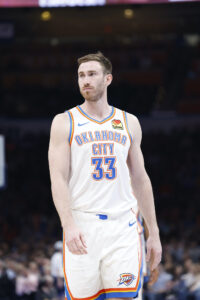Fans of lottery-bound NBA teams will be keeping a close on the bottom of the league’s standings down the stretch because of the effect that “race” will have on the draft order and lottery odds for the 2024 first round.
However, it’s not just the first round of the draft that’s worth keeping an eye on. Those reverse standings will also dictate the order of the draft’s second round, and an early second-round pick can be nearly as valuable as a first-rounder.
[RELATED: Traded Second-Round Picks For 2024 NBA Draft]
Here are a few of the traded 2024 draft picks that will land near the top of the second round:
From: Washington Wizards
To: Utah Jazz
Current projection: No. 31
Technically, the Jazz will receive whichever of the Wizards’ or Grizzlies’ second-round picks is most favorable, while the Timberwolves will receive the least favorable of the two.
Even at 23-43, Memphis has an 11.5-game lead on the 11-54 Wizards in the standings, so we can safely assume Washington’s pick will be more favorable than the Grizzlies’ second-rounder and will head to Utah.
The Wizards initially traded the most favorable of those two picks to Brooklyn in 2021’s five-team deal that sent Spencer Dinwiddie from the Nets to D.C. via sign-and-trade. The Nets later attached the pick to DeAndre Jordan in a salary-dump deal with Detroit. The Pistons, in turn, sent it to Utah at this season’s trade deadline in the Simone Fontecchio swap.
From: Detroit Pistons
To: Toronto Raptors
Current projection: No. 32
The Pistons’ 2024 second-round pick was one of several future second-rounders they gave up for the right to draft Saddiq Bey in 2020. The Clippers acquired it at that time, then sent it to New York a year later in order to move up four spots to No. 21 in the 2021 draft to select Keon Johnson — that was a nice move for the Knicks, who used No. 25 to nab Quentin Grimes.
New York eventually used the Pistons’ pick about two-and-a-half months ago as a sweetener in the OG Anunoby trade with the Raptors. At the time, Detroit had the NBA’s worst record, so the pick was projected to be 31st overall. It may not ultimately land there, but given the Pistons’ 11-53 record, it will still be one of the top selections of the second round.
From: Charlotte Hornets
To: Portland Trail Blazers
Current projection: No. 34
The Hornets probably have no regrets about trading this second-rounder to New Orleans back in 2020 in order to acquire the No. 42 overall pick in that draft, which they used to select Nick Richards — Richards has been Charlotte’s starting center for much of this season, whereas there’s no guarantee that whoever is picked 34th overall this year will still be in the league in four years.
The Pelicans used the pick a few days later during the 2020 offseason as part of a package to acquire Steven Adams from the Thunder. Oklahoma City later flipped it to Denver, giving the Nuggets either the Hornets’ or Timberwolves’ 2024 second-rounder (whichever is most favorable).
Denver sent that pick to Portland at the 2022 draft in exchange for the No. 46 selection, which was used on Ismael Kamagate, whom the Nuggets ultimately turned into $2.68MM in cash at this season’s deadline.
Technically, the “most favorable” language still applies, but there’s no question that the 16-49 Hornets will have a higher second-round pick than the 45-21 Timberwolves, so Portland will get Charlotte’s pick.
From: Portland Trail Blazers
To: Milwaukee Bucks
Current projection: No. 35
While the Trail Blazers are in position to acquire a top-35 pick from Charlotte, they’ll lose their own high second-round pick, which they initially included in a five-player 2020 trade that sent Trevor Ariza from Sacramento to Portland.
Two years later, the Bucks acquired Portland’s 2024 second-rounder from the Kings in a four-team deadline deal that saw Donte DiVincenzo head from Milwaukee to Sacramento. As a result, despite having one of the NBA’s best records this season, the Bucks are poised to control a pair of top-35 picks, since they still own their own first-rounder as well.
From: Memphis Grizzlies
To: Minnesota Timberwolves
Current projection: No. 36
As we noted above when discussing the Wizards’ pick, Utah will receive the most favorable of Washington’s and Memphis’ second-rounders, while Minnesota will acquire the least favorable of the two, which is certain at this point to be the Grizzlies’ selection.
Initially dealt to the Thunder in the 2019 draft so that Memphis could move up from No. 23 to No. 21 to draft Brandon Clarke, the Grizzlies’ 2024 second-rounder bounced around the league after that and was eventually acquired by the Timberwolves from the Lakers at the 2023 trade deadline in the three-team deal that sent D’Angelo Russell to Los Angeles and Mike Conley to Minnesota.
Although the Grizzlies have traded away their own second-rounder, they control Brooklyn’s second-round pick, which may end up just a couple spots lower (it’s currently No. 38).
From: Toronto Raptors
To: Indiana Pacers
Current projection: No. 37
The Raptors originally traded their 2024 second-rounder to the Grizzlies during the 2018/19 season as part of a larger package for center Marc Gasol — it’s safe to say that deal, which helped cement the franchise’s first-ever championship a few months later, was a worthwhile one.
The Clippers eventually acquired the pick from Memphis at the 2023 deadline as part of the return for Luke Kennard, then used it in a package to land James Harden from Philadelphia this past fall.
Some “most favorable” language was attached to the pick in the Harden blockbuster, and that language still applied when the Sixers flipped it to Indiana in the Buddy Hield trade last month. However, the the 23-42 Raptors would have to pass the 37-29 Pacers or the 41-24 Cavaliers for any team besides Indiana to receive this pick, so it’s safe to assume it’ll land with the Pacers.

 The salary limitations that apply to Non-Bird rights are more severe than those pertaining to Bird rights or Early Bird rights, so in many cases, the Non-Bird exception may not be enough to retain a well-regarded free agent. For instance, the Nuggets held
The salary limitations that apply to Non-Bird rights are more severe than those pertaining to Bird rights or Early Bird rights, so in many cases, the Non-Bird exception may not be enough to retain a well-regarded free agent. For instance, the Nuggets held 
 As is the case with Bird rights, a player’s clock stops when he’s released by a team and clears waivers, but it would pick up where it left off if he re-signs with that same team down the road without joining another club in the interim. For instance,
As is the case with Bird rights, a player’s clock stops when he’s released by a team and clears waivers, but it would pick up where it left off if he re-signs with that same team down the road without joining another club in the interim. For instance,  For instance, the Thunder will hold
For instance, the Thunder will hold  It was Wembanyama who got the upper hand in the latest chapter of the budding rivalry between the two young bigs on Thursday night. The No. 1 overall pick, who led the Spurs to an upset win over the Thunder, became the first player in NBA history to record at least 25 points, 10 rebounds, five assists, five blocks, and five 3-pointers in a game, according to
It was Wembanyama who got the upper hand in the latest chapter of the budding rivalry between the two young bigs on Thursday night. The No. 1 overall pick, who led the Spurs to an upset win over the Thunder, became the first player in NBA history to record at least 25 points, 10 rebounds, five assists, five blocks, and five 3-pointers in a game, according to